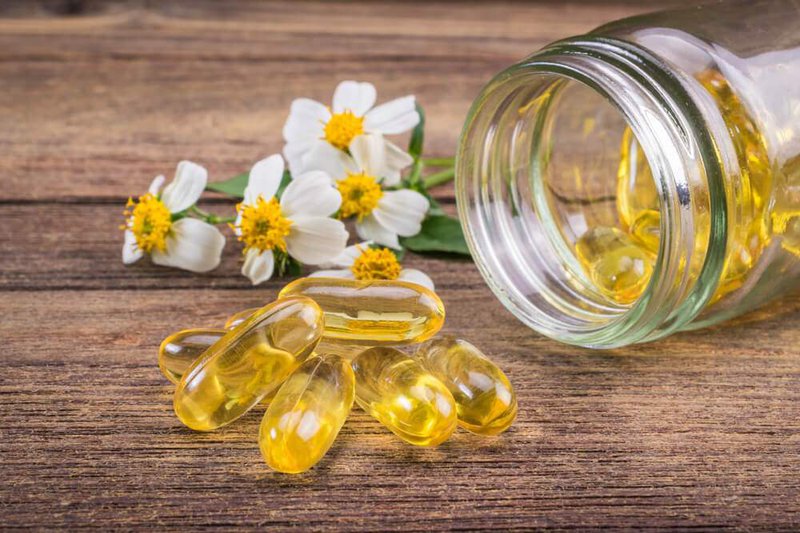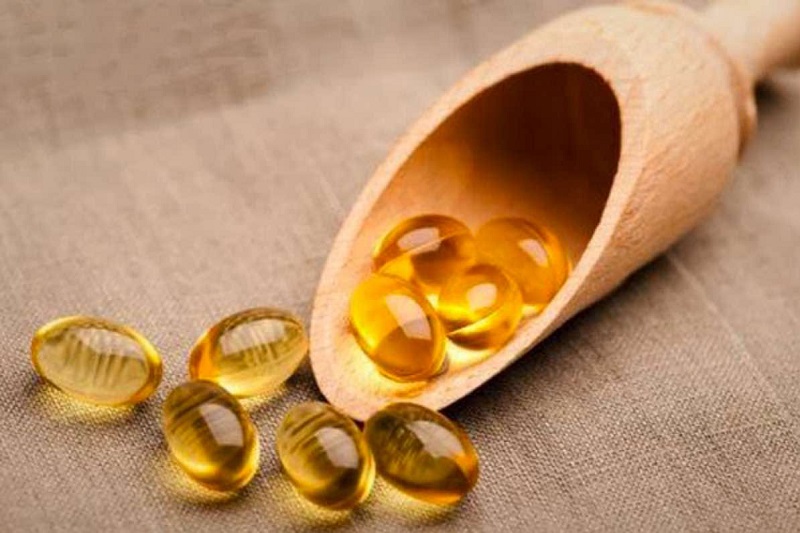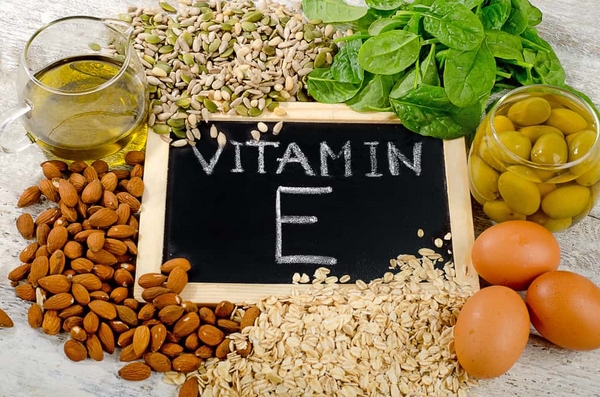What is vitamin E?
 Source: Internet
Vitamin E is one of the many types of nutrient-rich antioxidants available to us in both food and supplemental form. This powerful, fat-soluble, lipid-based vitamin helps heal and block the damage created by free-radicals in the body’s natural processes of digestion and cellular repair. Overtime, high levels of free-radical buildup can speed up our natural aging process, as well as increase our chances for developing an inflammatory condition, heart disease and even cancer.
Mechanisms of Action in Vitamin E
When we say the word “Vitamin E,” what we are really referring to is a group of eight different antioxidants that are eight different forms isomers of Vitamin E. Vitamin E contains four types of tocotrienols:
Source: Internet
Vitamin E is one of the many types of nutrient-rich antioxidants available to us in both food and supplemental form. This powerful, fat-soluble, lipid-based vitamin helps heal and block the damage created by free-radicals in the body’s natural processes of digestion and cellular repair. Overtime, high levels of free-radical buildup can speed up our natural aging process, as well as increase our chances for developing an inflammatory condition, heart disease and even cancer.
Mechanisms of Action in Vitamin E
When we say the word “Vitamin E,” what we are really referring to is a group of eight different antioxidants that are eight different forms isomers of Vitamin E. Vitamin E contains four types of tocotrienols:
- alpha-tocotrienol
- beta-tocotrienol
- gamma-tocotrienol
- delta-tocotrienol
- alpha-tocopherol
- beta-tocopherol
- gamma-tocopherol
- delta-tocopherol
 Source: Internet
Here are a few ways in which vitamin E may help in the prevention and treatment of specific common ailments and diseases:
Alzheimer’s Disease: Some studies have linked Alzheimer’s to oxidative cellular damage, so the anti-oxidative effects of vitamin E could help in this regard. Studies have also shown that vitamin E may improve mental focus in healthy individuals. It may also aid in treating depression, and increase concentration in individuals with dementia.
Prevents cardiovascular disease: Researchers have found that oxidative changes to LDL-Cholesterol (“bad” cholesterol) may promote blockages in coronary arteries (blood clots). Vitamin E’s anti-oxidative properties help limit the amount of oxidation to the LDL blocking the conversion of cholesterol into artery plaque (fat deposits on our blood vessel walls). One study done on 90,000 hospital nurses showed that nurses taking the highest levels of vitamin E had up to 40% less indices of heart disease.
Aids in metabolic processes such as immune function and DNA repair. Helps to fight infections and disease.
Menopausal and Post-menopausal benefits: Large studies have shown that vitamin E may reduce the incidence of stroke in postmenopausal women. Vitamin E has also been shown to aid in easing hot flashes and macular degeneration, as well as cardiovascular disease in menopausal women.
Possible cancer prevention: Oftentimes, individuals with cancer have lower levels of vitamin E. Studies have suggested that eating a diet high in antioxidants, including vitamin E, might be linked to lowered incidence of colon, breast and prostate cancer.
Osteoarthritis: A few studies have shown that the use of vitamin E may be helpful in pain-relief by reducing inflammation in osteoarthritis patients.
Eye health: Vitamin E reduces the inflammation in the uvea of the eye. This may aid in maintaining visual clarity, as well as reducing your chances of cataracts and macular degeneration.
Prevents inflammatory diseases such as pancreatitis, arthritis and inflammatory bowel disease.
Eases premenstrual symptoms such as breast swelling and tenderness.
Incorporating Vitamin E into Your Daily Diet
One of the best ways of getting more of this antioxidant vitamin into your body is through the foods you eat on a daily basis. The most common foods containing high levels of vitamin E are green leafy vegetables, vegetable oils, cereals, and nuts.
The following foods are especially high in vitamin E:
Source: Internet
Here are a few ways in which vitamin E may help in the prevention and treatment of specific common ailments and diseases:
Alzheimer’s Disease: Some studies have linked Alzheimer’s to oxidative cellular damage, so the anti-oxidative effects of vitamin E could help in this regard. Studies have also shown that vitamin E may improve mental focus in healthy individuals. It may also aid in treating depression, and increase concentration in individuals with dementia.
Prevents cardiovascular disease: Researchers have found that oxidative changes to LDL-Cholesterol (“bad” cholesterol) may promote blockages in coronary arteries (blood clots). Vitamin E’s anti-oxidative properties help limit the amount of oxidation to the LDL blocking the conversion of cholesterol into artery plaque (fat deposits on our blood vessel walls). One study done on 90,000 hospital nurses showed that nurses taking the highest levels of vitamin E had up to 40% less indices of heart disease.
Aids in metabolic processes such as immune function and DNA repair. Helps to fight infections and disease.
Menopausal and Post-menopausal benefits: Large studies have shown that vitamin E may reduce the incidence of stroke in postmenopausal women. Vitamin E has also been shown to aid in easing hot flashes and macular degeneration, as well as cardiovascular disease in menopausal women.
Possible cancer prevention: Oftentimes, individuals with cancer have lower levels of vitamin E. Studies have suggested that eating a diet high in antioxidants, including vitamin E, might be linked to lowered incidence of colon, breast and prostate cancer.
Osteoarthritis: A few studies have shown that the use of vitamin E may be helpful in pain-relief by reducing inflammation in osteoarthritis patients.
Eye health: Vitamin E reduces the inflammation in the uvea of the eye. This may aid in maintaining visual clarity, as well as reducing your chances of cataracts and macular degeneration.
Prevents inflammatory diseases such as pancreatitis, arthritis and inflammatory bowel disease.
Eases premenstrual symptoms such as breast swelling and tenderness.
Incorporating Vitamin E into Your Daily Diet
One of the best ways of getting more of this antioxidant vitamin into your body is through the foods you eat on a daily basis. The most common foods containing high levels of vitamin E are green leafy vegetables, vegetable oils, cereals, and nuts.
The following foods are especially high in vitamin E:
- Wheat germ oil
- Spinach
- Kiwi fruit
- Tomatoes
- Dandelion Greens
- Bran-based Cereals
- Hazelnuts
- Broccoli
- Almonds
- Fish
- Mango
- Sunflower seeds
- Beet Greens
- Sunflower and Safflower oil
 Possible Risks Associated with Vitamin E Consumption
According to the Food and Nutrition Board of the Institute of Medicine, healthy adults can take a maximum of 1,000 mg of vitamin E daily. When taken in foods, there is no evidence of any risks in over-consumption of vitamin E. However, vitamin E as a supplement may cause allergic reactions when combined with other medications. Extremely high doses can interfere with the body’s use of other vitamins, and experimentally-induced toxicity levels have shown increased clotting times. If you are taking any medications, consult with your physician or pharmacist before consuming vitamin E in a supplement form.
Source: http://www.antioxidants.org/vitamin-e
References and Other Resources:
Brigelius-Flohé, Regina and Traber, Maret G., “Vitamin E: function and metabolism,” The FASEB Journal, 1999;13:1145-1155
Lonn, EM and Yusuf S., “Is there a role for antioxidant vitamins in the prevention of cardiovascular diseases? An update on epidemiological and clinical trials data,” The Canadian Journal of Cardiology, 1997; 13:957-65
Institute of Medicine (U.S.). Panel on Dietary Antioxidants and Related Compounds, Institute Of Medicine, Dietary Reference Intakes: Vitamin C, Vitamin E, Selenium, and Carotenoids, National Academy Press, Washington, DC, 2000.
Jialal, I. and Fuller, C.J., “Effect of vitamin E, vitamin C and beta-carotene on LDL oxidation and atherosclerosis,” Canadian Journal of Cardiology, 1995; 11 Suppl G:97G-103G, http://www.ncbi.nlm.nih.gov/pubmed/7585302.
Malafa, M.D., Mokenge P. “New insights and gains in pancreatic cancer”. Cancer Control: Journal of the Moffitt Cancer Center, 2008; 15 (4): 276-277
National Cancer Institute, The SELECT Prostate Cancer Prevention Trial, U.S. National Institutes of Health, updated 12/02/2008, http://www.cancer.gov/clinicaltrials/digestpage/SELECT. Rimm, Eric B., et al., “Vitamin E consumption and the risk of coronary heart disease in men,”The New England Journal of Medicine, 1993; 328:1450–6
Sesso, H.D., et al., “Vitamins E and C in the Prevention of Cardiovascular Disease in Men: The Physicians’ Health Study II Randomized Controlled Trial,” 2008, JAMA; 300 (18): 2123-2133,
Stampfer, M.J., et al., “Vitamin E consumption and the risk of coronary disease in women,” The New England Journal of Medicine, 1993; 328:1444-9
Agricultural Research Service. 2004. “USDA National Nutrient Database for Standard Reference,” U.S. Department of Agriculture, Release 16-1,
Agricultural Research Service. 2004. “USDA National Nutrient Database for Standard Reference,” U.S. Department of Agriculture, Release 16-1,
The Vitamin and Supplement Guide, “Foods Containing Vitamin E – Can You Get Enough from Your Diet?” The-Vitamin-and-Supplement-Guide.com
National Standard Patient Monograph, “Vitamin E,” National Standard Research Collaboration, 2009,
NorthwesterNutrition, “Nutrition Fact Sheet: Vitamin E,” Northwestern University, Feinberg School, Department of Preventive Medicine, Last Updated 07/27/07,
Possible Risks Associated with Vitamin E Consumption
According to the Food and Nutrition Board of the Institute of Medicine, healthy adults can take a maximum of 1,000 mg of vitamin E daily. When taken in foods, there is no evidence of any risks in over-consumption of vitamin E. However, vitamin E as a supplement may cause allergic reactions when combined with other medications. Extremely high doses can interfere with the body’s use of other vitamins, and experimentally-induced toxicity levels have shown increased clotting times. If you are taking any medications, consult with your physician or pharmacist before consuming vitamin E in a supplement form.
Source: http://www.antioxidants.org/vitamin-e
References and Other Resources:
Brigelius-Flohé, Regina and Traber, Maret G., “Vitamin E: function and metabolism,” The FASEB Journal, 1999;13:1145-1155
Lonn, EM and Yusuf S., “Is there a role for antioxidant vitamins in the prevention of cardiovascular diseases? An update on epidemiological and clinical trials data,” The Canadian Journal of Cardiology, 1997; 13:957-65
Institute of Medicine (U.S.). Panel on Dietary Antioxidants and Related Compounds, Institute Of Medicine, Dietary Reference Intakes: Vitamin C, Vitamin E, Selenium, and Carotenoids, National Academy Press, Washington, DC, 2000.
Jialal, I. and Fuller, C.J., “Effect of vitamin E, vitamin C and beta-carotene on LDL oxidation and atherosclerosis,” Canadian Journal of Cardiology, 1995; 11 Suppl G:97G-103G, http://www.ncbi.nlm.nih.gov/pubmed/7585302.
Malafa, M.D., Mokenge P. “New insights and gains in pancreatic cancer”. Cancer Control: Journal of the Moffitt Cancer Center, 2008; 15 (4): 276-277
National Cancer Institute, The SELECT Prostate Cancer Prevention Trial, U.S. National Institutes of Health, updated 12/02/2008, http://www.cancer.gov/clinicaltrials/digestpage/SELECT. Rimm, Eric B., et al., “Vitamin E consumption and the risk of coronary heart disease in men,”The New England Journal of Medicine, 1993; 328:1450–6
Sesso, H.D., et al., “Vitamins E and C in the Prevention of Cardiovascular Disease in Men: The Physicians’ Health Study II Randomized Controlled Trial,” 2008, JAMA; 300 (18): 2123-2133,
Stampfer, M.J., et al., “Vitamin E consumption and the risk of coronary disease in women,” The New England Journal of Medicine, 1993; 328:1444-9
Agricultural Research Service. 2004. “USDA National Nutrient Database for Standard Reference,” U.S. Department of Agriculture, Release 16-1,
Agricultural Research Service. 2004. “USDA National Nutrient Database for Standard Reference,” U.S. Department of Agriculture, Release 16-1,
The Vitamin and Supplement Guide, “Foods Containing Vitamin E – Can You Get Enough from Your Diet?” The-Vitamin-and-Supplement-Guide.com
National Standard Patient Monograph, “Vitamin E,” National Standard Research Collaboration, 2009,
NorthwesterNutrition, “Nutrition Fact Sheet: Vitamin E,” Northwestern University, Feinberg School, Department of Preventive Medicine, Last Updated 07/27/07,
Bài Viết Liên Quan
0 Comments

